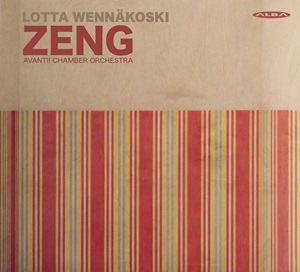
Lotta Wennäkoski (b. 1970)
Zeng (2018/2019)¹
I stället för vingar (2014/2016)²
Päärme (2015)³
Kuule II (2007)⁴
Hele (2018)
Lucie Horsch (recorders)¹, Virpi Räisänen (mezzo-soprano)², Emil Holmström (piano)³, Eriikka Maalismaa (violin)³, Mikko Ivars (cello)³, Heikki Nikula (bass clarinet)⁴, Avanti! Chamber Orchestra/József Hárs
rec. 2021, Järvenpää-talo, Järvenpää, Finland
Alba ABCD 529 [63]
Lotta Wennäkoski’s disc of orchestral music was one of my recordings of the year 2023 (review). I praised the vivid orchestral textures and formal mastery, and said that much more was to come. Indeed! The pieces here, which call for reduced orchestral or instrumental forces, span some ten years of her composing life. That allows a broader assessment of her oeuvre.
The first work is the most recent. The composer’s notes mention a one-year stay in Hungary at the Bartók Conservatory, and the importance of the exposition to Hungarian folk music that remains with her until now. Zeng for recorders, percussion and string quartet or orchestra is inspired, so she tells us, by two folk songs (AzénlovamSzajkó and Magosarutafa, if you want to know). I suspect they are more often buried in the instrumental tissue than quoted right away, although one may notice folk-inflected material here and there. The composer also says that the rhythmic and acoustic idea of Zeng is based on the bouncy, grotesque rhythm of the gardon, an instrument that looks like a cello but is plucked and beaten with a stick. That may account for the capriciousness of much of the music.
The piece opens with an arresting surprise, and goes along playfully till the music gives way to a suspended, mysterious central section. That is again followed by energetic music which builds up to a final flicker before melting away on a soft whip clap. Zeng is a good example of Wennäkoski’s music-making – seriously thought-out while allowing mild irony to have its say. Mention must be made of the demanding part for recorders, which Lucie Horsch plays beautifully.
Wennäkoski’s music is quite often triggered by an extra-musical idea, but words may also be an inspiration. The short song cycle Isälletförvingar sets texts by Eva-Stina Byggmästar, a Swedish poet from Ostrobothnia. The composer describes these poems as “both very expressive and raw, sometimes ironic, and wild, sometimes heartbreakingly melancholic”. Judging by the English translations, one may readily accept this description. I would add that they also have a surreal tinge. Scored for mezzo-soprano, clarinets, percussion and double bass, the music aptly reflects the various moods which the words suggest. It is in turn rough, aggressive, pensive and achingly beautiful. Mezzo-soprano Virpi Räisänen and her colleagues deliver carefully prepared and committed readings, often technically taxing but never at the expense of expression.
The basic idea behind the piano trio Päärme – Wennäkoski’s first – is “sewing” or “hemming”. The music signals “light, bright and pulsing” movement, although there is a long, slow, sustained middle section as a matter of contrast to the generally exuberant preceding music. The work eventually builds up forcefully before ticking away lightly. This very fine piece again makes huge demands on its performers. They do the music, and the composer, full justice.
KuuleII was written as a cello concerto, and then “edited”, as the composer says, into a more concise concerto for bass clarinet. (I wonder if the original version is extant.) The music, agreeably varied, becomes at times considerably impassioned before eventually ending calmly away, all passion spent. Heikki Nikula navigates it almost effortlessly, and the music is again rather exacting but never gratuitously so. KuuleII is a most welcome addition to the relatively limited repertoire for bass clarinet.
Hele, the last work, is scored for ensemble. In Estonian and in Finnish, the word suggests, among others, light and brightness – remarkably achieved here. The music is quite often ironic and humorous, particularly since it calls for unusual instruments such as a typewriter (so tastefully used one hardly notices) and various bird whistles which suggest joyfully disturbing dawn choruses.
This selection of works for smaller instrumental forces bears ample proof, if any was needed, of Lotta Wennäkoski’s broad stylistic and formal outlook. There is always a strong emphasis on expression, no matter how complex or taxing her music may be. All concerned deserve full marks for their immaculate technique and impeccable musicality, and the recorded sound is excellent. I wonder why these superb performances had to wait two years before a commercial release. Anyway, here is another programme that will appeal to the admirers of Lotta Wennäkoski’s music.
Hubert Culot
Buying this recording via a link below generates revenue for MWI, which helps the site remain free



















